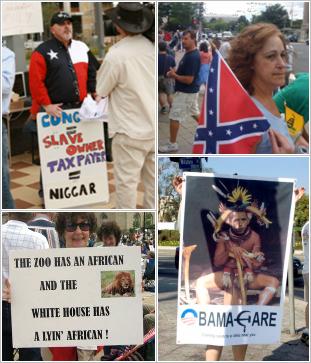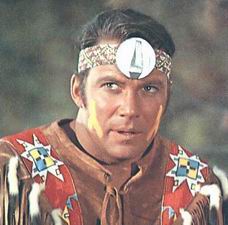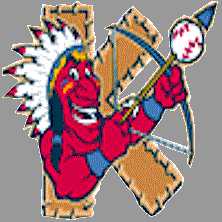As you may recall, last year the TV comedy
Happy Endings revealed that one of its characters, Dave, was 1/16 Navajo. I analyzed that bit in
"Navajo" in Happy Endings.
This year
Happy Endings did a follow-up bit for
Thanksgiving. Titled
More Like Stanksgiving (airdate: 11/21/12), it supposedly exposed Dave to the history of Indians in America.
Here are its references to Indians. First, Alex announces that she and Dave will prepare a Thanksgiving meal. Dave reminisces:
DAVE: Although, this time of year is always a little bittersweet for me.
[Knowing Dave is about to launch into some faux-Indian nonsense, the others groan and sigh.]
DAVE: Thanksgiving is a real reminder of my people's hardships. As an American living with 1/16th Navajo-ism, I'm going to use this as an opportunity to educate, perhaps enlighten, all you white people and throw an authentic Thanksgiving.
BRAD [gestures at himself because he's black]: White people?
DAVE: You guys wouldn't understand. None of your ancestors were at the first Thanksgiving.
JANE: Okay, neither were the Navajo.
DAVE: One of our many snubs.
JANE: Yeah.At their apartment, Dave asks Alex about the clams she was supposed to buy. She thought it was a mistake and bought clamps instead.
DAVE: Al, quahog clams were a featured dish in the first Thanksgiving.
DAVE [sighs]: I guess I gotta go get some now to prove to you guys how much better an authentic Thanksgiving is.
ALEX: Oh, Dave, c'mon. I respect your cultural traditions.
ALEX [gets a tray of tipi-shaped treats from the refrigerator]: That's why...I made...Navaho-hos.
DAVE: Tepees, Al? The Navajo did not live in tepee. I am deeply...offended by this.
[He takes a treat.]On his mission to buy clams, Dave is at a gas station getting gas. He's wearing a fringed leather jacket to signify his Native side:
DAVE [to passersby]: Baa Ahééwiindzin Bijí. Happy day of thankfulness.
PASSERBY: Oh, shut up.
MAN [in a Pilgrim's outfit]: Excuse me, sir? We were headed to the Thanksgiving Day parade when our car ran out of gas about a mile away.
WOMAN [in a Pilgrim's outfit]: Can we borrow a few dollars for gas?
DAVE: The irony. You see, it's the custom of my people to help strangers in need. And this on the day of thanksgiving.
DAVE: You know what, I'm gonna hit the ATM.
MAN: Nice guy.
WOMAN: Total sweetheart.While Dave gets cash, he sings to himself about his "heart of an eagle." Meanwhile, the "Pilgrims" get in his car. When Dave approaches the car window, they snatch his money and wallet, then drive off.
Without his phone, Dave can't call for help. Still eager to fulfill his mission, he enters a deli and asks for clams. The proprietor complies:
PROPRIETOR: All right, here are your quahogs.
DAVE: Great. One detail. I don't have any traditional money....
PROPRIETOR: Well, no clams then.
DAVE: C'mon, man, here's the dealio. Some Pilgrims stole my car and phone, so I can't call my friends because I don't know any of their numbers. I called the cops, but apparently they won't take me to get clams because they, quote, aren't a taxi service for idiots. So I was hoping that you and I could have a little barter situation here vis-à-vis...a trade.
PROPRIETOR: This is a real store.
DAVE: If I don't show up with a sack of clams I'm gonna look like a real dope.
PROPRIETOR: I do like that jacket.
DAVE: This jacket for some clams? I mean, this thing is choice. Plus it's 30 degrees outside. You're trying to trick me into a very uneven trade. The story of my people.
PROPRIETOR: White people?
DAVE: You who focus on 15/16ths of a man.
PROPRIETOR: Tell you what. The clams...plus this blanket.
DAVE [exasperated]: Fine.
PROPRIETOR: Fine.
DAVE: Fine.
[They make the trade.]
DAVE: Joke's on you. All my friends hate that jacket.As he goes outside, Dave sneezes. He realizes the blanket may have cat hair on it, which he's allergic to. He looks back and see the proprietor stroking a cat.
Dave in trouble
Sneezing, shivering, and desperate for money, Dave remembers he has one thing of value in his pocket:
DAVE: Oh. My Rock Bottom Remainder tickets. I can sell these...for money.
DAVE: Mm. Thank you, rocking scribes.
DAVE [shouts to passersby]: Six tickets for Rock Bottom Remainders! Six tickets for Rock Bottom Remainders!
[A man approaches Dave.]
MAN: Hey, I love RBR. How much?
DAVE: 200 bucks.
MAN: All right, man. You gotta deal. That's great.
DAVE: Yeah? All right!
[The man pays for the tickets.]
DAVE: Oh, you don't understand what kind of day I've had. You see, I'm 1/16th Navajo--?
[The man grabs Dave, turns him around, and handcuffs him.]
MAN: Sir, you're under arrest for scalping.
DAVE: "Scalping"? "Scalping"?! Ah, c'mon, man! Why would you do this to a fellow Rock Bottom Remain dude? What are you doing looking for scalpers, anyway? We're nowhere near a concert venue.
MAN: No, but we are outside a police station.
[The man leads Dave, protesting, into the station.]
DAVE: "Scalping"? The Pilgrims drove me to it!Finally Dave returns to the apartment without the clams. The others hadn't noticed he was gone. He narrates what happened with the police:
DAVE: --and then they got my car back.
[The others make sounds of happiness.]
DAVE: But, then they confiscated my RBR tickets.
[The others make fake sounds of sympathy.]
DAVE: But it wasn't all bad. I mean I wanted an authentic Thanksgiving and I got so much more. I experienced the entire plight of the Native American people in just one day.
JANE: Ohh, no you didn't.
PENNY: That is wildly insensitive.
DAVE: And, 'cuz of my hardships, I feel as though I've earned the right to bestow upon myself my own Indian name.
PENNY: Oh.
DAVE: So henceforth, I'll be known as "Has Ordeals with Clams."
BRAD: I don't like it.
MAX: Now, is that a legal name change? Or is this like the time you wanted us to call you "Lindsey"?
DAVE: It's so much bigger than that.
PENNY: Oh, excuse me, Linds.Analysis
My thoughts on the
Stanksgiving episode:
The good
It's great to see Native history in any format--especially in a network TV show where people aren't expecting. And for a silly comedy,
Happy Endings does a reasonable job of recapitulating that history. Traditional foods, welcoming strangers, ripped off by Pilgrims, getting cheated in trades, given infected blankets, forced to scalp and punished for it...that about sums it up. At least through the 19th century.
As it did last time,
Happy Endings also gets credit for using a genuine Navajo phrase. Anything that indicates Native languages are still spoken is good.
The bad
The show doesn't distinguish between true and false, misleading, or stereotypical information. In the first category, the Navajo weren't at the first Thanksgiving and didn't live in tipis. In the second category, Indians generally don't wear fringed leather jackets or give themselves
"funny Indian names."
The show has no "voice of reason." All six characters are kind of buffoonish. So there's no one to point out the difference between true and false or stereotypical. That limits the already limited educational value of the episode.
The ugly
Even if Dave is a comical character who suffers for his effrontery, he's still a white man adopting a phony Native identity. He isn't an enrolled Navajo and he wasn't raised in the Navajo culture. He has no excuse for pretending to be an Indian rather than a white man with Native roots.
His situation is reminiscent of
Elizabeth Warren's. But once her background became known, she didn't claim to be a Cherokee or act like one. She stuck to honoring her (alleged) Native heritage based on her family stories.
That's an appropriate response. Appropriating a Native identity isn't. If Dave told a group of Indians he was 1/16 Navajo and wanted to share "his" culture, they'd criticize and scorn him.
Yet no one really challenges Dave except to groan or sigh. No one tells him, "The joke's over, Dave. By pretending that a drop of Native blood makes you Native, you're insulting real Indians. This is deeply offensive if not outright racist. Stop it now or I'm leaving."
The show is normalizing the idea that
New Agers,
wannabes, or anyone with a faint connection to Indians can "choose" to be Native. There's an implication that Indians existed in the past but are now gone. All that's left is white people upholding some almost-forgotten Native traditions.
We've heard similar "reasoning" in many cases. Starlets will justify saying or wearing something stereotypical because they're a tiny bit Native. Companies will justify their stereotypical marketing images because the founder talked to someone who said it would be okay. In each case, non-Indians invent reasons to appropriate a culture that isn't theirs.
How about putting a real Native character in these Native-themed episodes of
Happy Endings? Have someone who could straighten Dave out about claiming to be Navajo, wearing a fringed jacket, adopting a "funny Indian name," etc. That would be more enlightening than this halfhearted attempt to share Native culture via white people.
It would be funnier, too. I can just imagine the double-takes and eye-rolling as a real Indian listened to Dave pontificate about his ancestors. That kind of reality is what's missing from
Happy Endings' take on Indians.
Overall impressions
Here's one reviewers take on the episode:
Happy Endings "More Like Stanksgiving" Review: Has Ordeals With Clams
by Bill KuchmanHoliday-themed sitcom episodes are always tricky proposals; it's easy for writers to get sucked into penning sappy storylines. I consider How I Met Your Mother to be the gold standard of Thanksgiving episodes, having given us both "Slapsgiving" and "Blitzgiving." After "More Like Stanksgiving," it looks like Happy Endings is ready to join that rarified air.
First off, "More Like Stanksgiving" was an excellent Happy Endings episode, possibly the best one of Season 3 thus far. Every character was in play, every member of the group delivering line after line of great material. The actual holiday of Thanksgiving was a part of the episode without the entire thing coming off like an after-school special. There wasn't some gooey message telling us how to feel at the end. And like HIMYM's "Slapsgiving" and "Blitzgiving" episodes, the story in this episode wasn't exactly the family dinner stuff Norman Rockwell would've painted. Dave claiming to have experienced the entire Native American plight because he got caught scalping tickets? Brilliant.I'll agree that the Native story arc was well-constructed. I didn't think it was particularly funny. The other parts of the episode were funnier.
Overall, I'd say it was a good episode, not a great one. Like a lot of comedies these days,
Happy Endings excels at snappy one-liners. It's ultimately forgettable because the characters are story props, not real people with depth.
For more on the subject, see
Halloween Party in Happy Endings and
Navajo Writes for Happy Endings.
Below: Dave the "Navajo" just before the "Pilgrims" rip him off.
























